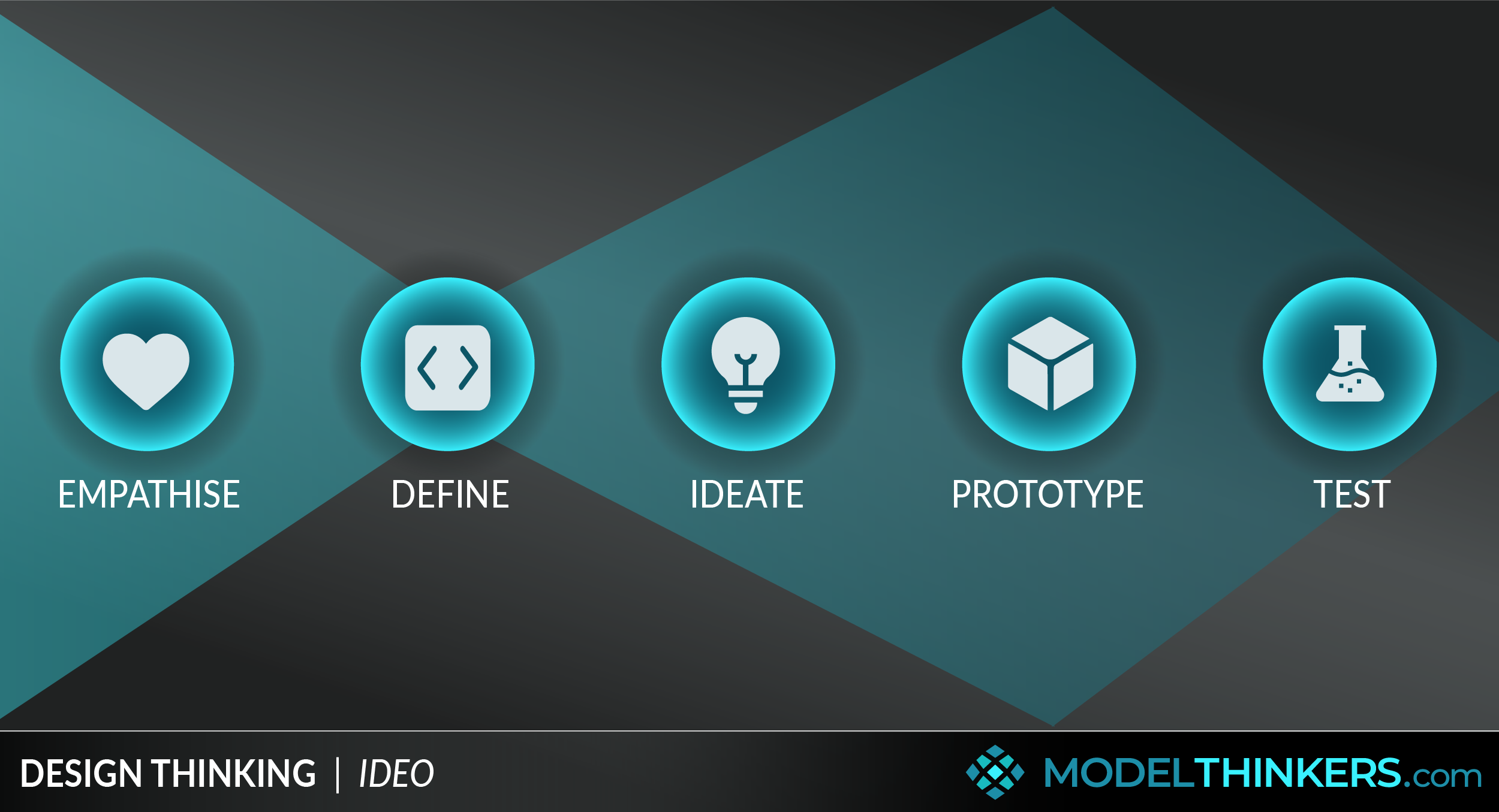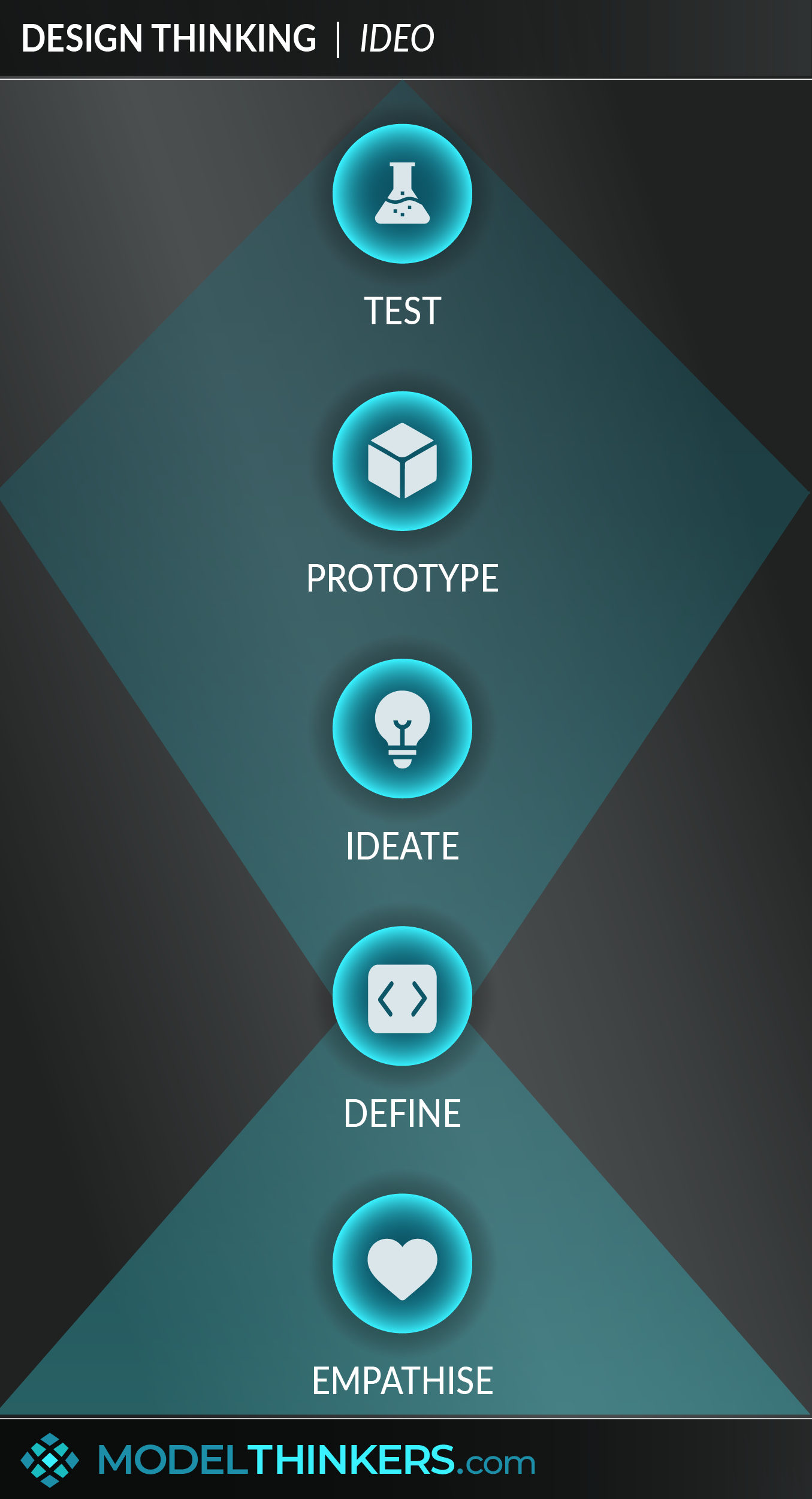

 0 saved
0 saved
 30.7K views
30.7K views








"The main tenet of design thinking is empathy for the people you’re trying to design for.” — David Kelley, Founder of IDEO
Design Thinking is a loose set of mindsets, practical tools and processes that help to innovate around and solve complex problems by starting with empathy, reframing the problem, using co-design to generate ideas, prototyping, and testing.
THE POWER OF DESIGN.
Design Thinking leverages familiar design-based approaches and applies them to broader disciplines and challenges. While it considers what’s feasible and technically possible, what’s viable and driven by business needs, design thinking unashamedly begins from a place of desirability and what will meet human needs.
HUMAN-CENTRED.
That human-centred approach is a key mindset of Design Thinking. Beyond that, it relies on a willingness to be optimistic through ambiguity, to embrace experimentation and failing fast, and co-design focusing on visual collaboration and the approach of showing rather than telling.
PROCESS.
Design Thinking is interpreted and applied in a variety of ways, though a typical process might involve the following elements:
- Empathy: developing a deep understanding of the audience needs and situation through empathy-based interviews or observations.
- Define: challenging assumptions, potentially reframing the question, and defining the problem to be solved.
- Ideate: often involving cross-functional teams and members of the target audience to ideate potential solutions.
- Prototype: identifying possible solutions to progress and creating low fidelity prototypes so audience members can preview the experience.
- Test: taking prototypes into the field to better understand audience needs and further inform and iterate the solution.
IN YOUR LATTICEWORK.
Some of the tools commonly associated with Design Thinking include Personas, Empathy Maps and Journey Maps, or Jobs to be Done Framework, to understand audience needs; the Five Whys as part of interviews or general discovery to challenge assumptions; card sorts to quickly parse information and identify patterns; problem statements to define the challenge; and of course Prototyping.
In addition, Design Thinking is often run along with organisations that use Agile Methodology and Lean Thinking.




- Use design thinking for ambiguous and complex problems.
Design thinking is especially effective in complexity. If the question is straightforward or the answer is largely known, or a specific outcome is expected, it’s unlikely that design thinking will add much value.
- Start with empathy for your target audience.
Don’t get seduced by an idea because the technology has made it possible, or because you think it’s a great idea. Start with engaging, co-designing and empathising with your audience. Rather than asking what they want, ask about and observe their experience to draw out stories and identify underlying needs.
- Reframe the problem from a human-centred perspective.
After empathising, consider how to reframe and further define the challenge with your new insights and from a human-centred perspective. You might want to consider using ‘how might we…’ problem statements.
- Use co-design.
Design thinking generally involves a range of people from a variety of backgrounds and experiences, ideally including members of the intended audience. Consider how to design visually, using cards or virtual tools so people can quickly understand and interact with the ideas. And consider how to ‘show’ through illustrations or examples rather than tell.
- Fail fast.
Build out prototypes and ways to preview the experience and field test them early and often.
- Apply it dynamically, scale it, butcher it as required.
Rather than hold onto design thinking as a specific process and stages, focus on embracing the mindset shifts such as leading with empathy and failing fast, then be flexible with how and what you use to explore and solve a problem. Use tools that help, skip stages or mix up the order as it helps you move forward.
Some argue that Design Thinking is not new and was simply a rebadging of existing approaches. There is an element of truth to that, but design thinking advocates might counter that the sum is greater than the parts, and design thinking’s strength is popularising these approaches.
Another common criticism of Design Thinking tends to arise when it is implemented as a strict process, rather than a dynamic framework. It is ironic for a process that aims to increase innovation that it can be used in a narrow, process-driven way that in fact restricts exploration.
Linked to this criticism is the broad rollout of Design Thinking to a range of corporations, often consisting of an immersive workshop experience and the expectation that innovation will shift as a result. In reality, there are a number of factors that will support innovation, not least of those being Psychological Safety.
IBM and design thinking.
With a history of solution-based design, being influenced by technology as a key driver for innovation, IBM consciously embraced a human-centred approach, integrating design thinking with agile. Read about their approach and the IBM ‘design thinking loop’ here.
Transforming kids MRI scanning.
An early case study for design thinking was the application of the approach to GE healthcare X-Ray and MRI scanning procedures for children. After a process of empathy-based information gathering, the lead industrial designer of the project realised that, to a child, what they had was terrifying resembling ‘a brick with a hole in it.’
He applied design thinking approaches, gathering a diverse team including people from a local children's museum, and together they created the ‘adventure series’ scanner. This article explains: “In the Pirate Adventure, a visual transformation of the equipment that was available before, patients are on a dock. There is a shipwreck and some sandcastles in the corner. Children then work on the plank to be scanned.”
In many ways, design thinking is an umbrella approach to innovation that incorporates a range of mindsets, processes and tools, with the aim of complex problem solving.
Use the following examples of connected and complementary models to weave design thinking into your broader latticework of mental models. Alternatively, discover your own connections by exploring the category list above.
Connected models:
- Personas: a crucial tool to develop empathy.
- Jobs to be done: an alternative approach to considering user needs.
- Prototypes: as a crucial ingredient of design thinking.
- Journey maps and empathy maps: more key tools often used in design thinking processes.
Complementary models:
- Agile methodology: a powerful combination with design thinking.
Design thinking is also known as human-centered design.
It’s challenging to attribute a single originator to design thinking which, as we’ve pointed out, is a collection of approaches under a broad innovation umbrella. IDEO has often been credited with coming up with it, particularly Tom Kelley and Tim Brown.
We credited IDEO with it — but it’s more complicated. To IDEO’s credit, they acknowledge this fact with their own history of how design thinking developed and the many thinkers of the last few decades who contributed to it.
There are many wonderful resources about design thinking, in particular IDEOs design kit and Stanford’s dschool.
 My Notes
My Notes
Oops, That’s Members’ Only!
Fortunately, it only costs US$5/month to Join ModelThinkers and access everything so that you can rapidly discover, learn, and apply the world’s most powerful ideas.
ModelThinkers membership at a glance:






“Yeah, we hate pop ups too. But we wanted to let you know that, with ModelThinkers, we’re making it easier for you to adapt, innovate and create value. We hope you’ll join us and the growing community of ModelThinkers today.”







































































































































